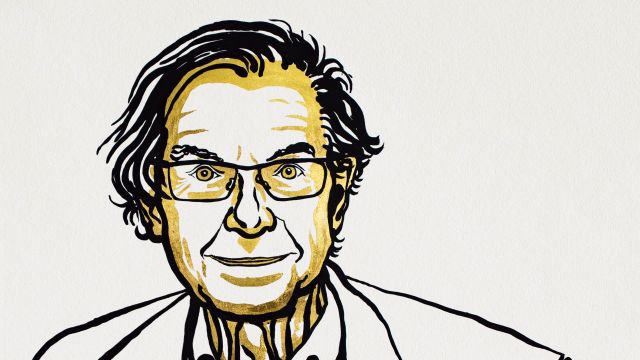Sir Roger Penrose shares the prize with Reinhard Genzel and Andrea Ghez, who discovered that an invisible and extremely heavy object governs the orbits of stars at the centre of our galaxy.
A supermassive black hole is the only currently known explanation.
This morning Roger Penrose found out he had been awarded this year's #NobelPrize in Physics.
Shortly afterwards he sent us this photo from his home in Oxford. Stay tuned for our phone interview with him - coming soon. pic.twitter.com/EaZxSthlaS— The Nobel Prize (@NobelPrize) October 6, 2020
On receiving the award, Sir Roger said: “It was an extreme honour and great pleasure to hear the news this morning in a slightly unusual way.
“I had to get out of my shower to hear it.”
He added that he got a call from his personal assistant who had received a “strange message”, and she wasn’t allowed to talk about it as it was “deadly secret”.
But while waiting for the call, Sir Roger decided to have a shower. He was worried about being “stark naked” and having to tell them, if asked, what he was doing at the time.
“It wasn’t quite like that,” he reassured press during a video call.
The Royal Swedish Academy of Sciences made the announcement on Tuesday, setting out that Sir Roger would take home half of the 10 million Swedish kronor (£864,000) prize, with the other two winners splitting the other half.
Sir Roger, who was born in Colchester in 1931, used “ingenious mathematical methods” in his proof that black holes are a direct consequence of Albert Einstein’s general theory of relativity, the committee said.
It added that Einstein did not himself believe that black holes – super-heavyweight monsters that capture everything that enters them – really exist.
How a black hole is formed (see figure).
The 2020 #NobelPrize in Physics has been awarded with one half to Roger Penrose and the other half jointly to Reinhard Genzel and Andrea Ghez. pic.twitter.com/OcCngdQxfG— The Nobel Prize (@NobelPrize) October 6, 2020
Advertisement
In January 1965, 10 years after Einstein’s death, Sir Roger, Emeritus Professor at the Mathematical Institute of the University of Oxford, proved that black holes really can form and described them in detail – at their heart, black holes hide a singularity in which all the known laws of nature cease.
The panel said: “His groundbreaking article is still regarded as the most important contribution to the general theory of relativity since Einstein.”
Sir Roger said he used to think about possible theories on his morning walks to the Tube station, and the idea came to him one day as he crossed the road with a colleague, leaving him with a feeling of “elation”.
He added: “I think people were very sceptical at the time – it took a long time before black holes became accepted.
“They are pretty well accepted now, their importance is – I think – only partially appreciated.”
Sir Roger was Stephen Hawking’s PhD examiner, and jointly won the Wolf Prize in physics with him for the Penrose-Hawking singularity theorems.
Asked how he felt about receiving the prize so long after his black hole findings, he said: “I think it’s a bad thing – if you’ve got great ambitions, or do science, it’s a bad thing to get a Nobel Prize too early.
“I know people who got their prizes, I would consider too early, and it spoiled their science.
“I think if you’re going to get a Nobel Prize for science, it’s a good thing to get it good and old, before you’re absolutely clapped out I suppose, but while there’s still something to do.”
Sir Roger added: “I’m just about old enough, I think. I’m only in my 90th year so I guess that’s OK.”
Professors Genzel and Ghez, born in Germany and America respectively, each lead a group of astronomers that, since the early 1990s, has focused on a region called Sagittarius A* at the centre of our galaxy.
The orbits of the brightest stars closest to the middle of the Milky Way have been mapped with increasing precision.
The measurements of these two groups agree, with both finding an extremely heavy, invisible object that pulls on the jumble of stars, causing them to rush around at dizzying speeds.
Around four million solar masses are packed together in a region no larger than our solar system.
Using the world’s largest telescopes, the pair developed methods to see through the huge clouds of interstellar gas and dust to the centre of the Milky Way.
Roger Penrose – awarded this year’s #NobelPrize in Physics – was born in 1931 in Colchester, UK.
He is a professor at @UniofOxford, UK.https://t.co/Jm9iOU99N3 pic.twitter.com/Vsm7xHZivv— The Nobel Prize (@NobelPrize) October 6, 2020
According to the committee, their pioneering work has given us the most convincing evidence yet of a supermassive black hole at the centre of the Milky Way.
David Haviland, chair of the Nobel committee for physics, said: “The discoveries of this year’s Laureates have broken new ground in the study of compact and supermassive objects.
“But these exotic objects still pose many questions that beg for answers and motivate future research.
“Not only questions about their inner structure, but also questions about how to test our theory of gravity under the extreme conditions in the immediate vicinity of a black hole.”,







